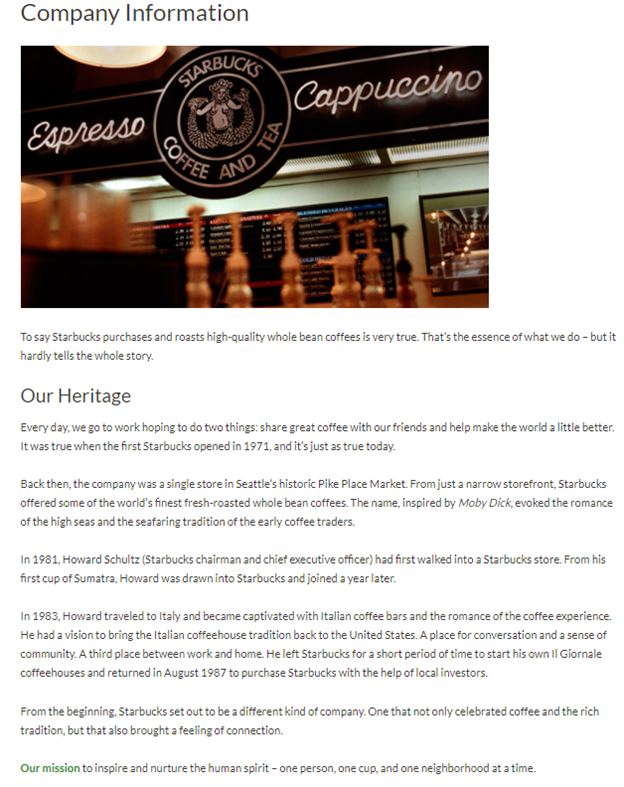The story of your company's evolution may seem uninspiring to you, but it can play an important role in building trust and respect. Every company has been shaped by moments of inspiration, perseverance, courage or luck. Your company history should feature the most compelling highlights of your entrepreneurial journey, along with significant achievements, such as patents and major wins.
You should include your history in your business plan and employee handbook, and on your website's "about us" page. Some companies write a book about their corporate story that is presented to employees and others on special occasions. The message behind your corporate milestones can even become the cornerstone of your brand.
What should your company history include?
Although the details of your company history are unique to your business, there are four key elements that every company history should include:
- Why your company was started
- A brief profile of the founders
- Major turning points in your company's life
- Amusing and inspirational events that have occurred along the way
How to write a company history
Follow these six steps to write an effective company history that accurately and informatively describes your business.
1. Read other company histories.
Get inspired by seeing how other companies have recounted their background. Microsoft tells its multifaceted success story with a few articles that recount some of the company's most noteworthy achievements over the last decade.
2. Dig for industry and company highlights.
Did you make a mark on your industry with a breakthrough product or a new twist on an old concept? Explain your company's achievements in the context of your industry's history.
3. Elicit memories.
Bring history to life by including anecdotes from employees and customers who were when your company was just starting out. Ask these folks if you can interview them about their experiences.
4. Create a timeline.
Once you have gathered your historical facts, record each event on a timeline.
5. Consult corporate history professionals.
If you prefer, hire a professional to research and write your history.
6. Picture it.
Use photos to illustrate your company's history. Include old snapshots of the founders, and snap photos of today's employees while they work. While you're at it, take photos of historic documents and other corporate artifacts – they also help tell your story.
Tips for writing a successful company history
Your company history can serve as a marketing tool. There are a few do's and don'ts to keep in mind when writing a company history. For example, unless you plan to publish a book about your company, don't let your story get bogged down with too much detail.
Focus on your major achievements, and add interesting anecdotes from employees and customers where you can. Be honest about how your company got to where it is – it's OK to include failed product launches and other less-than-flattering events, but tie them to important lessons you or the founders learned that contributed to later success.
Your company history should also give readers a sense of your corporate culture; ask employees if they have a special fondness for certain company traditions. Look back at how you have celebrated your company's birthdays and other special occasions.
It is important to properly record and update your company history as time goes on. For example, keep a record of where you found each piece of information that you expect to include in your history, since you'll need to refer back to these sources while you're writing. Additionally, your company's story doesn't end when you have completed your corporate history project. Maintain a file of significant events so that as your company grows, you can update its story.

Examples of company histories
If you are struggling to write your company history, there are several well-known organizations you can look to for company history examples. Each company overview is as unique as the business it is describing.
Starbucks
Starbucks' company history is both informative and easy to read. It includes a brief profile of the founders, the company background and mission statement, and the major company turning points. It does all this while using descriptive and imaginative language. The casual and friendly tone of the company history matches the atmosphere it strives to bring to coffee lovers each day.
"Every day, we go to work hoping to do two things: share great coffee with our friends and help make the world a little better," the company wrote on its website. "It was true when the first Starbucks opened in 1971, and it's just as true today."
Starbucks goes on to detail where its first store was located, where its name came from, and how its chairman and CEO, Howard Schultz, was drawn to the company. Starbucks also includes its mission statement.
"To inspire and nurture the human spirit – one person, one cup, and one neighborhood at a time."

Adidas
Adidas takes a unique approach to its company history. The forward-thinking sports brand is all about power, speed and achievement. This mission is clearly conveyed in their company profile. Instead of a written profile, the company intersperses the company's history with an informative infographic that highlights its brand story and achievements. By highlighting these facts and figures in a way that is quick to digest, readers can quickly grasp what the company is all about.

American Airlines
As your company grows, you should tailor your company history to match current marketing conventions. For example, American Airlines has been around for almost 100 years. They tailored its company history to a brief, one-paragraph overview, with an expandable interactive timeline that covers seminal events in the company's history.
 Judy Artuniansk
Judy Artuniansk
Additional reporting by Judy Artunian.
